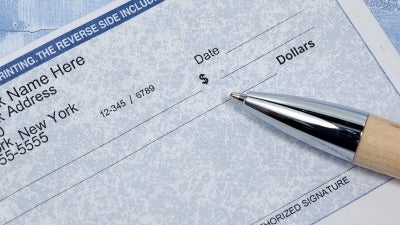Home > Ask SmallBizClub > Legal >
Can a three member LLC, being taxed as a partnership, place the three members on a payroll service with other employees of the company?
By: Rick Gossett

Can a three member LLC, being taxed as a partnership, place the three members on a payroll service with other employees of the company?
Answer: The members of an LLC taxed as a partnership cannot take W-2 salaries or wages like employees of the LLC and cannot therefore have their compensation processed through a payroll service. However, they make take salaries in the form of “guaranteed payments” and profit distributions from the LLC as discussed in greater detail below. They pay federal and state personal income taxes and the federal Self-Employment (SE) Tax on their guaranteed payments and their share of the LLC’s pass-through net income on their personal income tax returns. They pay these taxes through quarterly personal estimated tax payments.
An LLC is unique in that it can be taxed as a disregarded entity, partnership, C corp or S corp. A single member or owner LLC can be taxed as a disregarded entity, C corp or S corp. A multi-member or owner LLC can be taxed as a partnership, C corp or S corp. Unless an LLC elects corporate tax classification by filing Federal Form 8832 (C corp) or Federal Form 2553 (S corp) with the IRS when it is formed, a single member or owner LLC is taxed as a disregarded entity and a multiple member or owner LLC is taxed as a partnership. An LLC taxed as a disregarded entity is taxed as a sole proprietorship when the LLC is engaged in active trade or business activities.
An LLC taxed as a partnership is a pass-through entity for tax purposes. The LLC reports all of its income and expense on a separate tax return, Form 1065 and pays no tax on its net profit. The LLC passes through its net profit or loss to the partners based on their membership interest in the partnership. Each member’s share of the LLC’s net profit or loss is reported by the LLC on Schedule K-1. Each member reports the amounts from their respective Schedule K-1 on Schedule E of their personal Form 1040. Members do not take a W-2 salary but may take guaranteed payments, which the partnership deducts as a business expense, and/or periodic cash draws of their share of the LLC’s net profits, which the partnership cannot deduct as a business expense. However, members are taxed on their entire share of the LLC’s net profit regardless of whether they ever take profit distributions. Members are not required to withhold payroll taxes from their guaranteed payments or periodic cash draws, but they may need to make personal estimated income tax payments depending on their personal income tax situation. Generally, a member’s share of the LLC’s net profit will be subject to both federal and state personal income tax and, if net self-employment earnings are $400 or more, the Self-Employment or SE Tax.
You can review IRS and related information on partnerships, which applies to an LLC taxed as a partnership, at the following websites:
As to guaranteed payments, they cannot be based on the LLC’s profits or the member’s profit sharing percentages. You can review IRS Publication 541 above which states.
“Guaranteed payments are those made by a partnership to a partner that are determined without regard to the partnership’s income. A partnership treats guaranteed payments for services, or for the use of capital, as if they were made to a person who is not a partner. This treatment is for purposes of determining gross income and deductible business expenses only. For other tax purposes, guaranteed payments are treated as a partner’s distributive share of ordinary income. Guaranteed payments are not subject to income tax withholding.”
Members receiving guaranteed payments include those payments in their personal gross income and pay tax on them at ordinary income tax rates. Guaranteed payments are also subject to the SE Tax. The following are related discussions for your review:
As to estimated tax payments, self-employed individuals, including sole proprietors, partners of partnerships, and members of similarly taxed LLCs are required to pay their personal income taxes through estimated tax payments, which is the method used to pay tax on income that is not subject to withholding. Both the IRS and state tax authorities can impose penalties, referred to as underpayment of estimated tax penalties, for failing to make required estimated tax payments during the year. In order to avoid federal and state underpayment of estimated tax penalties, self-employed individuals need to pay their personal tax liabilities during the year as they earn the income that creates those tax liabilities rather than wait until April each year to make lump sum payments. In addition to personal federal and state income taxes, self-employed individuals are also required to pay the Self-Employment Tax (SE Tax) through estimated tax payments. The SE Tax applies when net self-employment earnings are $400 or more (approximately $434 in business net profit) and is assessed at a rate of 15.3%, which consists of Social Security tax of 12.4% and Medicare tax of 2.9% The SE Tax is calculated on Schedule SE which is filed along with Form 1040. Self-employed individuals may owe the SE Tax even if they do not owe personal income tax. You can review IRS information on the SE Tax at the following website:
While there are certain thresholds and exceptions, when your federal and state income tax withholding on wages and other income will not be sufficient to cover your expected personal income tax liabilities, you generally need to make quarterly estimated tax payments. To accurately determine your estimated tax payments, you will need to accurately project your personal income tax liabilities for the year. You can do this by completing a mock-up of your business and personal tax returns in which you project your business net income and other personal income, deductions, exemptions, tax credits and withholding to determine your annual taxable income and tax liabilities. Once you have projected your tax liabilities, you can then determine whether or not you are required to make quarterly payments or can simply pay the entire balance due with your tax returns next April. Plan on revisiting this process once each quarter to make certain that your estimated tax payments will be sufficient.
Generally, your annual estimated tax liability is due in quarterly installments payable on April 15, June 15, September 15 and January 15, respectively (see Iowa payment calendar below); however, instead of the Regular Installment Method you can elect to use the Annualized Income Installment Method to match your estimated tax payments more closely to your income and cash flow. Under the Annualized Income Installment Method, your quarterly estimated tax payments vary based on your estimated tax liabilities for specific periods of time during the year. This method works best when you expect to have lower income during the early quarters of the year and higher income during the later quarters of the year, but it is somewhat complicated to implement and may require the assistance of your accountant at least for the first year.
If you are required to make estimated tax payments but choose not to do so, be advised that you will owe an underpayment of estimated tax penalty if you do not pay enough during the year. The penalty will apply even if you pay your taxes in a lump sum every April. If you aren’t required to make estimated tax payments, then you should at least set aside funds to cover your projected tax liabilities during the year as you earn the income that generates those tax liabilities. This approach will allow you to better manage your cash flow and prevent the scramble every April to come up with the money to pay your taxes. As your business profitability increases your tax liability will also and it will become much harder to pay your taxes in a lump sum every April.
While you can research the estimated tax payment requirements yourself, members often find it beneficial—especially in the first year in business or when business net profitability increases substantially—to review their specific circumstances with a local accountant or CPA who can help them determine their business-related tax liabilities and reporting requirements and, if necessary, help properly prepare their tax returns. For discussion with your accountant, you can review information on federal and state estimated tax payments at the following websites:
Federal:
If you are still uncertain how to compensate yourselves, determine your business related tax liabilities and/or your estimated tax payment requirements after reviewing the above information, you may find it beneficial to consult a local tax advisor or CPA.
Published: August 14, 2013
9284 Views
9284 Views












